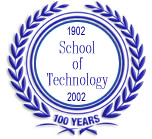
"Technology
and Us"
School of Technology
Centennial Symposium
An Extended Celebration

 |
"Technology
and Us" |
 |
|
|
Information
technology Information
technology has had a significant impact on education. Miniaturization,
increasing sophistication, and decreasing costs, among other things, have
foster varied and pervasive utilization of emerging technologies in educational
settings. Attempts to use technology to enhance student learning, and
to manage instructional and educational processes have been a driving
force in education for several decades. It is by no means a new phenomenon.
According to a survey done in 1984, the number of schools using microcomputers
had, in some cases, quintupled from 1981 to 1983 (Market Data Retrieval,
1985, p.5). Accordingly, a 1988 study conducted in Virginia schools indicated
that computers were the "...most numerous piece of instructional
equipment in elementary and secondary schools." (Heinich, Molenda
& Russell, 1993, p.19). In the 1980's, such trends were not restricted
to education. The Department of Commerce, Bureau of the Census found that
by 1989, approximately one third of the United States population used
a computer in one form or another (Kominski, 1991). More recently in the
past five to seven years, there has been rapid and significant growth
in the number of Internet-based distance education courses offered by
colleges and universities. A survey by the U.S. Department of Education's
National Center for Educational Statistics (NCES, 1999) found that from
1994-95 to 1997-98 the number of distance education programs using a variety
of technologies increased by 72 percent. The survey also indicated that
58 percent of all distance education courses provided by institutions
of higher education in 1997-98 used asynchronous Internet instruction
as their primary mode of instructional delivery. Institutions that offered
distance education courses in 1997-98 or that planned to offer distance
education in 1999-01 reported that they intended to start using or increase
the use of Internet-based technologies and two-way interactive video more
than any other type of technology. |